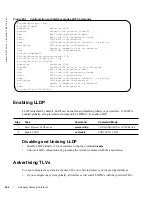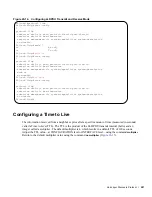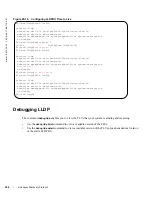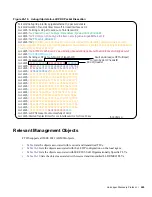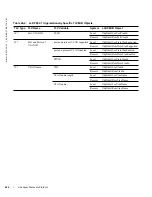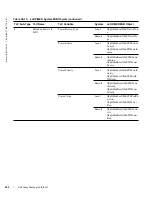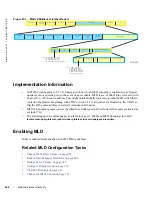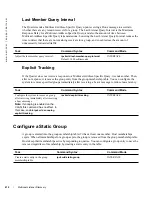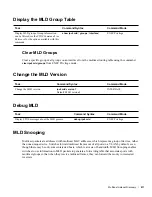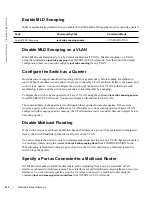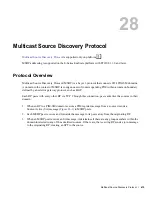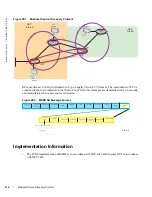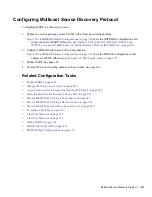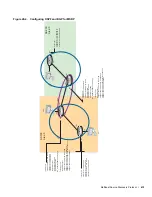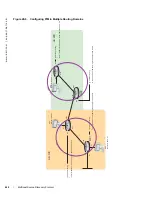
Multicast Listener Discovery |
605
27
Multicast Listener Discovery
Multicast Listener Discovery is supported only on platform:
e
MLD Snooping is supported only on platform:
e
Multicast Listener Discovery (MLD) is a Layer 3 protocol that IPv6 routers use to learn of the multicast
receivers that are directly connected to them and the groups in which the receivers are interested. Multicast
routing protocols (like PIM) use the information learned from MLD to route multicast traffic to all
interested receivers. MLD is analogous to IGMP, which tracks IPv4 multicast receivers.
Protocol Overview
MLD version 1 is analogous to IGMP version 2. MLD version 3 adds the ability to include and exclude
sources and is analogous to IGMP version 3.
MLD Version 1
Routers use MLD to learn which multicast addresses have listeners on each of their attached links. For
each link, the router keeps a list of which multicast addresses have listeners and a timer associated with
each of those addresses.
There are three types of MLD messages:
•
Multicast Listener Query
— a message sent by the Queerer to learn which multicast groups have
listeners.
•
General Query
— a query to which all listeners should respond.
•
Multicast-Address-Specific Query
— a query to which only listeners for the specified group
should respond.
•
Multicast Listener Report
— a message sent by listeners declaring their multicast group
subscriptions.
•
Multicast Listener Done
— a message sent by a listener declaring that it is leaving a multicast group.
Figure 27-1
shows the packet structure of MLD version 1 packets.
Summary of Contents for Force10 E300
Page 1: ...FTOS Configuration Guide FTOS 8 4 2 7 E Series TeraScale C Series S Series S50 S25 ...
Page 32: ...32 w w w d e l l c o m s u p p o r t d e l l c o m ...
Page 132: ...132 802 1X w w w d e l l c o m s u p p o r t d e l l c o m ...
Page 310: ...310 Configuration Replace and Rollback w w w d e l l c o m s u p p o r t d e l l c o m ...
Page 330: ...330 Dynamic Host Configuration Protocol w w w d e l l c o m s u p p o r t d e l l c o m ...
Page 402: ...402 High Availability w w w d e l l c o m s u p p o r t d e l l c o m ...
Page 462: ...462 Interfaces w w w d e l l c o m s u p p o r t d e l l c o m ...
Page 482: ...482 IPv4 Addressing w w w d e l l c o m s u p p o r t d e l l c o m ...
Page 506: ...506 IPv6 Addressing w w w d e l l c o m s u p p o r t d e l l c o m ...
Page 582: ...582 Layer 2 w w w d e l l c o m s u p p o r t d e l l c o m ...
Page 642: ...642 Multicast Source Discovery Protocol w w w d e l l c o m s u p p o r t d e l l c o m ...
Page 662: ...662 Multiple Spanning Tree Protocol w w w d e l l c o m s u p p o r t d e l l c o m ...
Page 690: ...690 Object Tracking w w w d e l l c o m s u p p o r t d e l l c o m ...
Page 754: ...754 PIM Dense Mode w w w d e l l c o m s u p p o r t d e l l c o m ...
Page 784: ...784 PIM Source Specific Mode w w w d e l l c o m s u p p o r t d e l l c o m ...
Page 800: ...800 Power over Ethernet w w w d e l l c o m s u p p o r t d e l l c o m ...
Page 876: ...876 Quality of Service w w w d e l l c o m s u p p o r t d e l l c o m ...
Page 892: ...892 Routing Information Protocol w w w d e l l c o m s u p p o r t d e l l c o m ...
Page 1006: ...1006 Simple Network Management Protocol w w w d e l l c o m s u p p o r t d e l l c o m ...
Page 1018: ...1018 SONET SDH w w w d e l l c o m s u p p o r t d e l l c o m ...
Page 1048: ...1048 Broadcast Storm Control w w w d e l l c o m s u p p o r t d e l l c o m ...
Page 1096: ...1096 Uplink Failure Detection UFD w w w d e l l c o m s u p p o r t d e l l c o m ...
Page 1098: ...1098 Upgrade Procedures w w w d e l l c o m s u p p o r t d e l l c o m ...
Page 1196: ...1196 C Series Debugging and Diagnostics w w w d e l l c o m s u p p o r t d e l l c o m ...
Page 1252: ...1252 Standards Compliance w w w d e l l c o m s u p p o r t d e l l c o m ...
Page 1262: ...1262 Index w w w d e l l c o m s u p p o r t d e l l c o m ...


